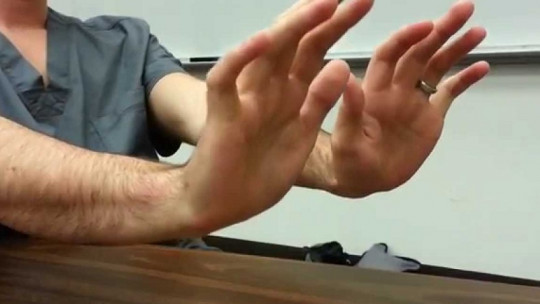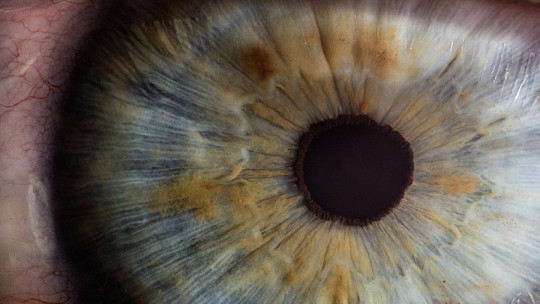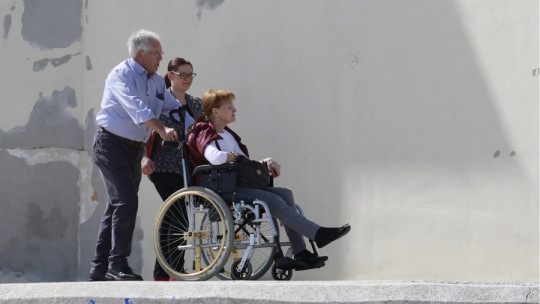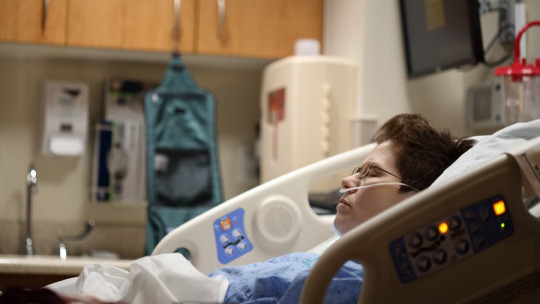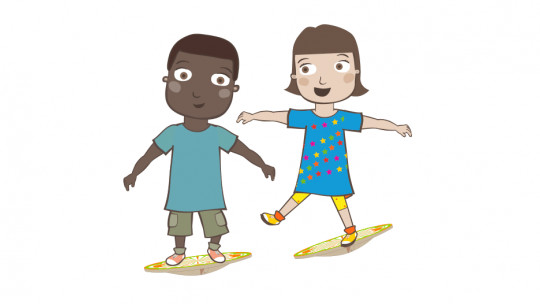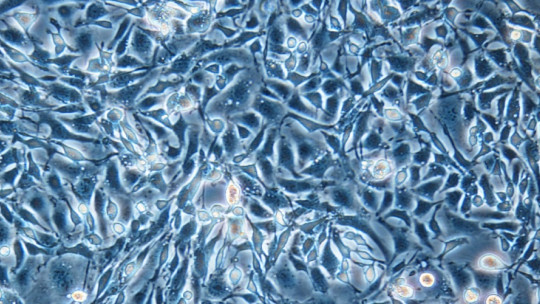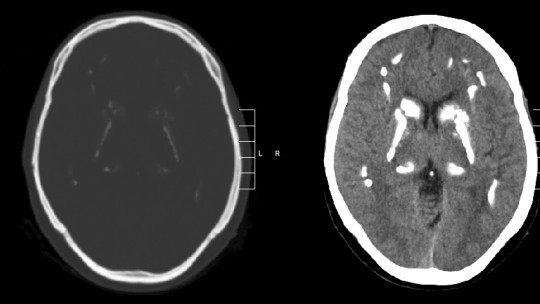Surely, many people who have tried to play a piano for the first time have had the same problem: when trying to play with both hands it has been impossible because, unconsciously, both hands moved the same fingers.
This is called synkinesis and is a relatively common phenomenon , especially in childhood. It is simply making an involuntary movement when doing another that is voluntary.
Although it may not be anything serious, there are cases in which they are symptoms of a severe neurological disease. Below we will discover what synkinesis are, what types there are, how they occur and what treatments currently exist.
What is synkinesis?
The word synkinesis refers to the involuntary muscle contraction associated with voluntary movement That is, these are uncontrolled movements that are produced by making a controlled movement with another limb or region of the body.
It is, basically, the difficulty in individualizing, dissociating or coordinating voluntary movement and preventing other unwanted movements from being generated.
In many cases, these involuntary movements are symmetrical and contralateral to the voluntary ones , such as, for example, moving the fingers of one hand and having the same fingers of the other do the same. Those on the face are also common, such as smiling and, involuntarily, causing the eye muscles to contract, causing the person to cross their eyes a little when smiling.
These types of unwanted movements They are common in childhood, and can be considered a non-pathological sign that the nervous system is still developing However, normally, from 10 to 12 years of age, the synkinesis attributed to normotypic growth begins to disappear.
Types of synkinesis
There are different types of synkinesis taking into account two criteria. One refers to the affected region of the body and type of movement, while the other refers to whether these are synkinesis that are expected in normal development or whether they are the result of some type of neurological injury.
Depending on the region involved
Depending on the region involved, we can talk about three main types of synkinesis:
1. Facial synkinesis
It is usually caused by paralysis of the facial nerve. Also called Bell’s palsy or facial palsy, It is believed that there could be a viral cause behind this neurological problem
The main type of synkinesis that occurs in this condition is that when trying to smile or move your mouth, muscles that you do not want to activate also move, making it difficult to speak, eat or swallow saliva.
2. Extraocular muscle synkinesis
The six muscles around the eye are innervated by three different cranial nerves : abducens (VI cranial nerve), trochlear (IV cranial nerve) and oculomotor (III cranial nerve).
After trauma near the eye, there may be failures to activate these muscles, causing the retraction and constriction of the pupil to be altered.
3. Bimanual synkinesis
Bimanual synkinesis It occurs when the upper limbs, and specifically the hands and fingers, execute exactly the same type of movement despite only wanting to voluntarily activate one hand.
This is called mirror hand movements, and it can persist throughout life. Although they do not have to be pathological, they can occur in serious conditions such as Parkinson’s disease and Kallmann syndrome.
According to their degree of normality
There are synkinesis that are due to normal physiological processes, especially during childhood. However, there are other cases that can be considered pathological.
1. Physiological synkinesis
Physiological synkinesis, especially in childhood, They are totally normal involuntary movements and do not have to mean that you suffer from a neurological problem
A clear example of this type of synkinesis would be bimanual synkinesis, observable when learning to play the piano even as an adult. It is very difficult for us to dissociate the movements of one hand from the other, unless it is practiced.
Another example of normal synkinesis is the movement we make with our arms when walking. While we walk we move our right arm forward and, at the same time and unconsciously, we move our left arm backward.
2. Pathological synkinesis
There are several synkinesis that could be considered pathological, associated with trauma and neurological diseases
On the one hand we have imitation movements, which consist of symmetrical and identical contralateral movements, in which the altered limb moves imitating the healthy limb.
On the other hand, we have global synkinesis, in which trying to move a single group of muscles activates others, making daily life difficult for the affected person. It usually occurs in diseases that cause hemiplegia.
Mechanisms
Three neurological mechanisms have been proposed to explain synkinesis.
Abnormal nerve regeneration
The hypothesis of anomalous nerve regeneration is the most accepted mechanism to explain synkinesis. This hypothesis maintains that, After trauma, axons project from the facial nucleus to the wrong peripheral muscles
These anomalous connections can simultaneously innervate different subdivisions of the facial nerve. This means that, when these pathways are activated, muscles that are not desired to be activated voluntarily are stimulated.
ephaptic transmission
Another explanation that has been considered to explain synkinesis is that of ephaptic transmission. Basically, this theory maintains that non-synaptic contacts are sometimes established between neighboring nerve fibers.
When one of them receives a nervous impulse, it also passes through the neighboring fibers as they are very close to each other causing muscles that were not initially wanted to be activated to also be stimulated and, therefore, activated.
Nuclear hyperexcitability
The nuclear hyperexcitability hypothesis maintains that axonal degeneration can occur after injury.
The postsynaptic cell that comes after this injured axon, by not receiving nervous stimulation, becomes increasingly sensitive to neurotransmitters, as if your tolerance towards them is reduced. As a consequence, if nearby axons that are not damaged release neurotransmitters, this cell deprived of its original axon receives stimulation from neighboring neurons, sending an impulse that does not correspond to it.
How are they evaluated?
To find out if there are synkinesis, there are different maneuvers to explore movements, both voluntary and involuntary. Generally, It consists of making them do a voluntary movement in which fine motor skills are involved although gross motor skills will also be required to be explored.
The patient can be asked to handle different objects or make different gestures with the face and hands to see if these voluntary movements are replicated in other regions of the face or on the ipsilateral side of the body.
Treatment
As we have mentioned, synkinesis does not have to be a pathological problem. Children present them as a sign of their still immature nervous system, and some adults may also present involuntary movements that are nothing more than slight discomfort in some of their daily activities.
However, yes There are cases in which you should be concerned, especially if the degree of intrusion of the involuntary movement is so great that it makes daily life very difficult of the affected person. Below we will see different therapeutic routes.
1. Face training
The idea behind facial training is that neurons are not something static That is, they create new projections depending on the stimuli they receive.
To reduce synkinesis, facial training teaches the patient techniques to increase desired movements while also focusing on reducing involuntary movements
For example, if the mouth always moves when the patient voluntarily blinks, the easy training technique will teach the patient to slowly close their eyes while actively focusing on keeping their mouth closed while doing this movement.
2. Botox
Botulinum toxin is being used to reduce synkinesis. It was originally used to reduce hyperkinesis after facial paralysis, but It was seen that it could be useful to work on involuntary movements, and could be reduced in just 3 days 2 or 3 sessions of botox can make involuntary movement disappear forever.
3. Surgery
Surgical procedures to treat synkinesis include neurolysis and selective myectomy Neurolysis has been shown to be effective in reducing synkinesis but only temporarily and, unfortunately, the symptoms can return, sometimes even increased.
In selective myectomy, the muscle that has presented synkinesis movement is selected and is removed or annulled. It is a much more effective technique, but it has the problem that Postoperative complications may occur, including medical problems such as edema, hematomas, and ecchymosis
It is because of these problems that surgical interventions to treat synkinesis are rarely used.


